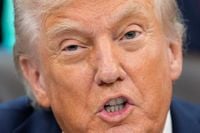When the National Football League announced earlier this week that Puerto Rican superstar Bad Bunny would headline the 2026 Super Bowl halftime show in Santa Clara, California, it set off a cultural and political earthquake—one that’s still rumbling across social media, sports talk shows, and even the halls of government. The decision, hailed by some as a celebration of global music and diversity, has drawn sharp criticism from others, revealing deep rifts not just over music, but about language, immigration, and American identity itself.
Bad Bunny, whose real name is Benito Antonio Martínez Ocasio, is no stranger to controversy—or to making history. His meteoric rise from the streets of Vega Baja, Puerto Rico, to the world’s biggest stages has been marked by a string of firsts: chart-topping hits, a wildly successful 31-date residency in San Juan, and now, the honor of performing at America’s most-watched television event. Yet, as NPR’s World Cafe reported, this latest achievement has been met with mixed reviews, and not just from music critics.
On October 2, 2025, former race car driver Danica Patrick took to X (formerly Twitter) to publicly blast the NFL’s choice. “No songs in English should not be allowed at one of America’s highest rated television events of the year … not just for sports,” Patrick wrote, echoing a sentiment that quickly gained traction among some English-only advocates. She didn’t stop there, reposting a wild claim that Bad Bunny is a “demonic Marxist” being given a platform at the Super Bowl. Patrick, who campaigned for Donald Trump during his 2024 presidential run, has never shied away from controversy herself, but her comments struck a nerve, igniting a broader debate about what—and who—the Super Bowl halftime show should represent.
The political backlash didn’t end with Patrick. According to Variety, President Donald Trump and his advisor Corey Lewandowski also weighed in, condemning the NFL’s decision. On the web series “The Benny Show,” Lewandowski issued a stern warning: “There is nowhere you can provide safe haven to people who are in this country illegally. Not the Super Bowl and nowhere else. We will find you and apprehend you and put you in a detention facility and deport you. Know that is a very real situation under this administration, which is contrary to how it used to be.” He went on to call the selection “shameful,” adding, “It’s so shameful they’ve decided to pick somebody who seems to hate America so much to represent them at the Halftime Show. We should be trying to be inclusive, not exclusive. There are plenty of great bands and entertainment people who could be playing at that show that would be bringing people together and not separating them.”
Concerns about immigration enforcement aren’t just rhetoric. A top Department of Homeland Security official confirmed that ICE agents will be patrolling around the Super Bowl site in February 2026, regardless of whether Bad Bunny approves. The artist himself has reason to be wary: in a recent interview with British magazine i-D, Bad Bunny said he previously canceled U.S. tour dates out of fear that ICE agents would be waiting outside his concerts. “But there was the issue of—like, f---ing ICE could be outside [my concerts],” he explained. “And it’s something that we were talking about and very concerned about.”
Despite the furor, NFL executive Jon Barker stood by the league’s selection. In a statement quoted by The New York Post, Barker defended the decision, saying, “Bad Bunny represents the global energy and cultural vibrancy that define today’s music scene. As one of the most influential and streamed artists in the world, his unique ability to bridge genres, languages, and audiences makes him an exciting and natural choice to take the Super Bowl halftime stage. We know his dynamic performances, creative vision, and deep connection with fans will deliver the kind of unforgettable experience we’ve come to expect from this iconic cultural moment.”
Indeed, Bad Bunny’s cultural impact is undeniable. His recent 31-date residency at the José Miguel Agrelot Coliseum in San Juan, Puerto Rico, dubbed No Me Quiero Ir de Aquí (“I Don’t Want to Leave Here”), drew half a million fans, with several shows reserved exclusively for Puerto Rico residents. The finale, livestreamed as “Una Mas” (“One More”) on Amazon Prime Video, shattered viewership records for a single-artist performance, according to Rolling Stone and NPR’s World Cafe. The concerts weren’t just musical spectacles—they were celebrations of Puerto Rican pride and resilience, complete with elaborate stage designs featuring plantain trees, live chickens and goats, and even a replica of a rural Puerto Rican home.
As Alt.Latino host Anamaria Sayre told NPR, Bad Bunny’s residency “had tremendous cultural resonance.” She explained, “[Bad Bunny] is basically taking advantage of a political moment, of a social moment, of a cultural moment that’s been happening for a number of years now in Puerto Rico… Basically, what he’s done—musically and just personally in how he talks and what he says—is he’s taken that concept and he’s basically adopted it as the overarching idea of his latest record and also this entire residency that he’s done on the island.”
Fellow host Felix Contreras likened the community atmosphere of the shows to that of a Grateful Dead concert: “That give-and-take with the audience, that sense of community that we’ve talked about already, it was very much like a Dead show.” Sayre added, “You sit in that room, like Felix said, and you feel the pride of what it feels like to be proud of where you’re from and to be unapologetic about that and to sing in Spanish and to scream in Spanish. I think that was mostly what mattered here is to flip the script on what it means to be from a colony, what it means to be from a country in Latin America. So that, to me, is really the lasting impact here.”
Bad Bunny himself has framed his Super Bowl performance as more than just a personal milestone. “This is for my people, my culture, and our history,” he declared after the announcement, making clear that he sees the halftime show as an opportunity to spotlight Puerto Rican identity and Latino culture on one of the world’s biggest stages.
Of course, not everyone is on board with that vision. The NFL was reportedly in talks with Taylor Swift for the halftime show, but those negotiations fell through. For some, Swift would have been a safer, more traditional pick. For others, Bad Bunny’s selection represents a bold step forward—a recognition that the face of American pop culture is changing, and that Spanish-language music and artists now command a global audience.
As the countdown to February 8, 2026, continues, one thing is certain: the Super Bowl halftime show will be anything but boring. Whether it’s a celebration of diversity or a flashpoint in the ongoing debate over immigration and identity, Bad Bunny’s performance is sure to be watched—and argued about—by millions.
For Bad Bunny and his fans, the show is a chance to bring the energy, pride, and community spirit of Puerto Rico to the center of American culture, if only for one unforgettable night.



